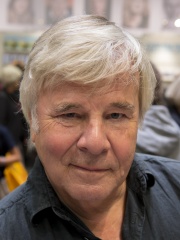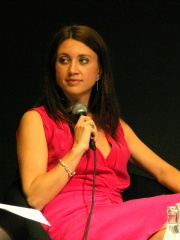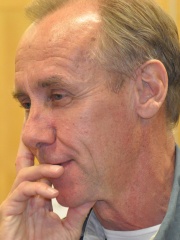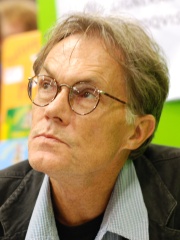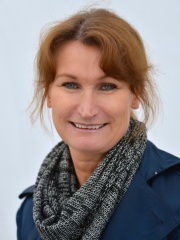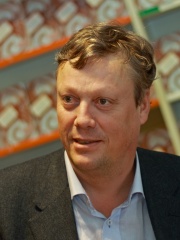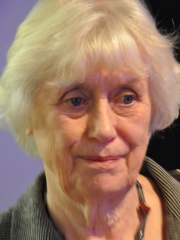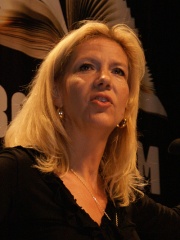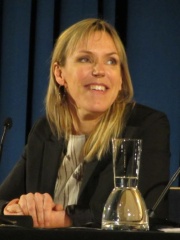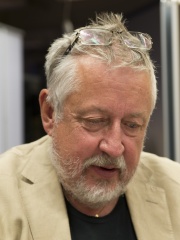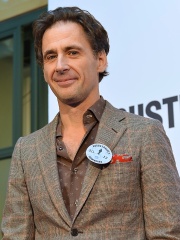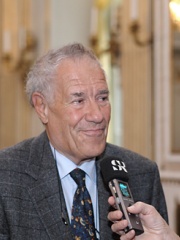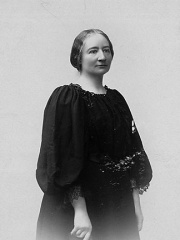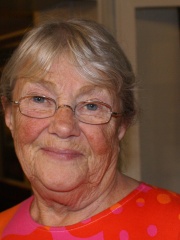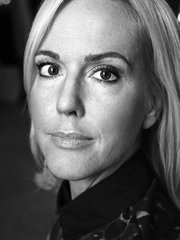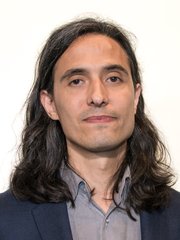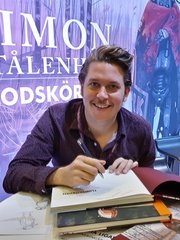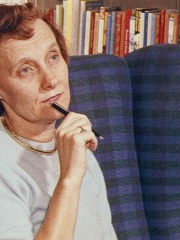
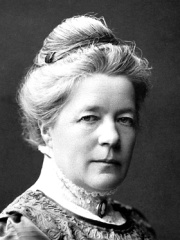
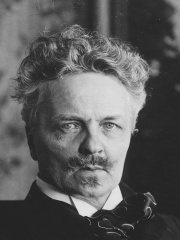
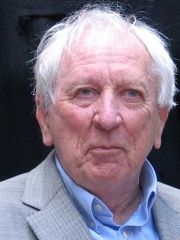
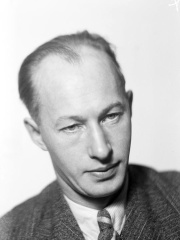

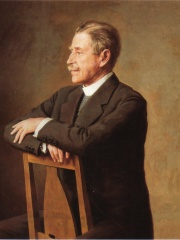
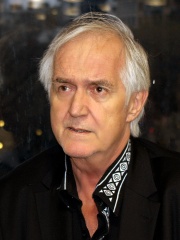
The Most Famous
WRITERS from Sweden
Top 10
The following people are considered by Pantheon to be the top 10 most legendary Swedish Writers of all time. This list of famous Swedish Writers is sorted by HPI (Historical Popularity Index), a metric that aggregates information on a biography's online popularity. Visit the rankings page to view the entire list of Swedish Writers.

1. Astrid Lindgren (1907 - 2002)
With an HPI of 83.96, Astrid Lindgren is the most famous Swedish Writer. Her biography has been translated into 99 different languages on wikipedia.
Astrid Anna Emilia Lindgren (Swedish: [ˈǎsːtrɪd ˈlînːɡreːn] ; née Ericsson; 14 November 1907 – 28 January 2002) was a Swedish writer of fiction and screenplays. She is best known for several children's book series, featuring Pippi Longstocking, Emil of Lönneberga, Karlsson-on-the-Roof, and The Six Bullerby Children (Children of Noisy Village in the US), and for the children's fantasy novels Mio, My Son; Ronia the Robber's Daughter; and The Brothers Lionheart. Lindgren worked on the Children's Literature Editorial Board at the Rabén & Sjögren publishing house in Stockholm and wrote more than 30 books for children. In 2017, she was calculated to be the world's 18th most translated author. Lindgren had by 2010 sold roughly 167 million books worldwide. In 1994, she was awarded the Right Livelihood Award for "her unique authorship dedicated to the rights of children and respect for their individuality". Her campaigning for animal welfare led to a new law, Lex Lindgren, in time for her 80th birthday.

2. Selma Lagerlöf (1858 - 1940)
With an HPI of 83.47, Selma Lagerlöf is the 2nd most famous Swedish Writer. Her biography has been translated into 115 different languages.
Selma Ottilia Lovisa Lagerlöf (, US also , Swedish: [ˈsɛ̂lːma ˈlɑ̂ːɡɛˌɭøːv] ; 20 November 1858 – 16 March 1940) was a Swedish writer. She published her first novel, Gösta Berling's Saga, at the age of 33. She was the first woman to win the Nobel Prize in Literature, which she was awarded in 1909. In 1914, she was the first woman to be granted a membership of the Swedish Academy.

3. August Strindberg (1849 - 1912)
With an HPI of 80.30, August Strindberg is the 3rd most famous Swedish Writer. His biography has been translated into 83 different languages.
Johan August Strindberg (; Swedish: [ˈǒːɡɵst ˈstrɪ̂nːdbærj] ; 22 January 1849 – 14 May 1912) was a Swedish playwright, novelist, poet, essayist, and painter. A prolific writer who often drew directly on his personal experience, Strindberg wrote more than 60 plays and more than 30 works of fiction, autobiography, history, cultural analysis, and politics during his career, which spanned four decades. A bold experimenter and iconoclast throughout his life, he explored a wide range of dramatic methods and purposes, from naturalistic tragedy, monodrama, and historical plays to his anticipations of expressionist and surrealist dramatic techniques. From his earliest work, Strindberg developed innovative forms of dramatic action, language, and visual composition. He is considered the "father" of modern Swedish literature and his The Red Room (1879) has frequently been described as the first modern Swedish novel. In Sweden, Strindberg is known as an essayist, painter, poet, and especially novelist and playwright, but in other countries he is known mostly as a playwright. The Royal Theatre rejected his first major play, Master Olof, in 1872; it was not until 1881, when he was thirty-two, that its première at the New Theatre gave him his theatrical breakthrough. In his plays The Father (1887), Miss Julie (1888), and Creditors (1889), he created naturalistic dramas that – building on the established accomplishments of Henrik Ibsen's prose problem plays while rejecting their use of the structure of the well-made play – responded to the call-to-arms of Émile Zola's manifesto "Naturalism in the Theatre" (1881) and the example set by André Antoine's newly established Théâtre Libre (opened 1887). In Miss Julie, characterisation replaces plot as the predominant dramatic element (in contrast to melodrama and the well-made play) and the determining role of heredity and the environment on the "vacillating, disintegrated" characters is emphasized. Strindberg modeled his short-lived Scandinavian Experimental Theatre (1889) in Copenhagen on Antoine's theatre and he explored the theory of Naturalism in his essays "On Psychic Murder" (1887), "On Modern Drama and the Modern Theatre" (1889), and a preface to Miss Julie, the last of which is probably the best-known statement of the principles of the theatrical movement. During the 1890s he spent significant time abroad engaged in scientific experiments and studies of the occult. A series of apparent psychotic attacks between 1894 and 1896 (referred to as his "Inferno crisis") led to his hospitalization and return to Sweden. Under the influence of the ideas of Emanuel Swedenborg, he resolved after his recovery to become "the Zola of the Occult". In 1898 he returned to play-writing with To Damascus, which, like The Great Highway (1909), is a dream-play of spiritual pilgrimage. His A Dream Play (1902) – with its radical attempt to dramatize the workings of the unconscious by means of an abolition of conventional dramatic time and space and the splitting, doubling, merging, and multiplication of its characters – was an important precursor to both expressionism and surrealism. He also returned to writing historical drama, the genre with which he had begun his play-writing career. He helped to run the Intimate Theatre from 1907, a small-scale theatre in Stockholm, modeled on Max Reinhardt's Kammerspielhaus, that staged his chamber plays (such as The Ghost Sonata).

4. Tomas Tranströmer (1931 - 2015)
With an HPI of 79.26, Tomas Tranströmer is the 4th most famous Swedish Writer. His biography has been translated into 97 different languages.
Tomas Gösta Tranströmer (Swedish: [ˈtʊ̌mːas ˈjœ̂sːta ˈtrâːnˌstrœmːɛr]; 15 April 1931 – 26 March 2015) was a Swedish poet, psychologist and translator. His poems captured the long winters in Sweden, the rhythm of the seasons and the palpable, atmospheric beauty of nature. Tranströmer's work is also characterized by a sense of mystery and wonder underlying the routine of everyday life, a quality which often gives his poems a religious dimension. He has been described as a Christian poet. Tranströmer is acclaimed as one of the most important Scandinavian writers since the Second World War. Critics praised his poetry for its accessibility, even in translation. His poetry has been translated into over 60 languages. He was the recipient of the 1990 Neustadt International Prize for Literature, the 2004 International Nonino Prize, and the 2011 Nobel Prize in Literature.
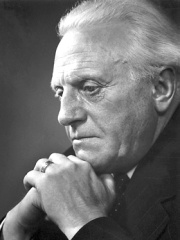
5. Pär Lagerkvist (1891 - 1974)
With an HPI of 76.22, Pär Lagerkvist is the 5th most famous Swedish Writer. His biography has been translated into 83 different languages.
Pär Fabian Lagerkvist (23 May 1891 – 11 July 1974) was a Swedish author who received the 1951 Nobel Prize in Literature. Lagerkvist wrote poetry, plays, novels, short stories, and essays of considerable expressive power and influence from his early 20s to his late 70s. One of his central themes was the fundamental question of good and evil, which he examined through such figures as Barabbas, the man who was freed instead of Jesus, and Ahasuerus, the Wandering Jew. As a moralist, he used religious motifs and figures from the Christian tradition without following the doctrines of a church.

6. Eyvind Johnson (1900 - 1976)
With an HPI of 74.90, Eyvind Johnson is the 6th most famous Swedish Writer. His biography has been translated into 77 different languages.
Eyvind Johnson (29 July 1900 – 25 August 1976) was a Swedish novelist and short story writer. Regarded as the most groundbreaking novelist in modern Swedish literature he became a member of the Swedish Academy in 1957 and shared the 1974 Nobel Prize in Literature with Harry Martinson with the citation: for a narrative art, far-seeing in lands and ages, in the service of freedom.

7. Harry Martinson (1904 - 1978)
With an HPI of 74.14, Harry Martinson is the 7th most famous Swedish Writer. His biography has been translated into 78 different languages.
Harry Martinson (6 May 1904 – 11 February 1978) was a Swedish writer, poet and former sailor. In 1949 he was elected into the Swedish Academy. He was awarded a joint Nobel Prize in Literature in 1974 together with fellow Swede Eyvind Johnson "for writings that catch the dewdrop and reflect the cosmos". The choice was controversial, as both Martinson and Johnson were members of the academy. He has been called "the great reformer of 20th-century Swedish poetry, the most original of the writers called 'proletarian'." One of his most noted works is the poetic cycle Aniara, which is a story of the spacecraft Aniara that during a journey through space loses its course and subsequently floats on without destination. The book was published in 1956 and became an opera in 1959 composed by Karl-Birger Blomdahl. The cycle has been described as "an epic story of man's fragility and folly".

8. Verner von Heidenstam (1859 - 1940)
With an HPI of 74.01, Verner von Heidenstam is the 8th most famous Swedish Writer. His biography has been translated into 82 different languages.
Carl Gustaf Verner von Heidenstam (6 July 1859 – 20 May 1940) was a Swedish poet, novelist and laureate of the 1916 Nobel Prize in Literature. He was a member of the Swedish Academy from 1912. His poems and prose work are filled with a great joy of life, sometimes imbued with a love of Swedish history and scenery, particularly its physical aspects.

9. Henning Mankell (1948 - 2015)
With an HPI of 73.84, Henning Mankell is the 9th most famous Swedish Writer. His biography has been translated into 54 different languages.
Henning Georg Mankell (Swedish pronunciation: [ˈhɛ̂nːɪŋ ˈmǎŋːkɛl]; 3 February 1948 – 5 October 2015) was a Swedish crime writer, children's author, and dramatist, best known for a series of mystery novels starring his most noted creation, Inspector Kurt Wallander. He also wrote a number of plays and screenplays for television. He was a left-wing social critic and activist. In his books and plays he constantly highlighted social inequality issues and injustices in Sweden and abroad. In 2010, Mankell was on board one of the ships in the Gaza Freedom Flotilla that was boarded by Israeli commandos. He was below deck on the MV Mavi Marmara when nine civilians were killed in international waters. Mankell shared his time between Sweden and countries in Africa, mostly Mozambique where he started a theatre. He made considerable donations to charity organizations, mostly connected to Africa.
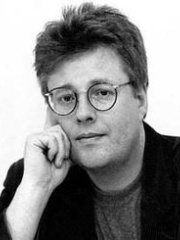
10. Stieg Larsson (1954 - 2004)
With an HPI of 70.63, Stieg Larsson is the 10th most famous Swedish Writer. His biography has been translated into 62 different languages.
Karl Stig-Erland "Stieg" Larsson (, Swedish: [ˈkɑːɭ stiːɡ ˈæ̌ːɭand ˈlɑ̌ːʂɔn]; 15 August 1954 – 9 November 2004) was a Swedish writer, journalist, and far-left activist. He is best known for writing the first trilogy in the Millennium series of crime novels, which was published posthumously, starting in 2005, after he died of a sudden heart attack. The trilogy was adapted as three motion pictures in Sweden, and one in the United States (for the first book only). Larsson had conceived of ten books in the series; the publisher commissioned David Lagercrantz to write the next trilogy, and Karin Smirnoff to write the third trilogy in the series, which has eight novels as of December 2025. For much of his life, Larsson lived and worked in Stockholm. His journalistic work covered socialist politics and he acted as an independent researcher of right-wing extremism. He was the second-best-selling fiction author in the world for 2008, owing to the success of the English translation of The Girl with the Dragon Tattoo, behind Afghan-American novelist Khaled Hosseini. The third and final novel in the Millennium trilogy, The Girl Who Kicked the Hornets' Nest, became the bestselling book in the United States in 2010, according to Publishers Weekly. By March 2015, his series had sold 80 million copies worldwide.
People
Pantheon has 104 people classified as Swedish writers born between 1493 and 1984. Of these 104, 38 (36.54%) of them are still alive today. The most famous living Swedish writers include Jan Guillou, Camilla Läckberg, and Håkan Nesser. The most famous deceased Swedish writers include Astrid Lindgren, Selma Lagerlöf, and August Strindberg. As of April 2024, 3 new Swedish writers have been added to Pantheon including Camilla Grebe, Jonas Hassen Khemiri, and Simon Stålenhag.
Living Swedish Writers
Go to all RankingsJan Guillou
1944 - Present
HPI: 66.67
Camilla Läckberg
1974 - Present
HPI: 64.30
Håkan Nesser
1950 - Present
HPI: 62.70
Sven Nordqvist
1946 - Present
HPI: 62.65
Viveca Sten
1959 - Present
HPI: 61.95
Jonas Jonasson
1961 - Present
HPI: 60.94
Kerstin Ekman
1933 - Present
HPI: 59.96
Liza Marklund
1962 - Present
HPI: 59.13
Åsa Larsson
1966 - Present
HPI: 58.88
Leif G. W. Persson
1945 - Present
HPI: 57.89
David Lagercrantz
1962 - Present
HPI: 57.65
Per Wästberg
1933 - Present
HPI: 56.58
Deceased Swedish Writers
Go to all RankingsAstrid Lindgren
1907 - 2002
HPI: 83.96
Selma Lagerlöf
1858 - 1940
HPI: 83.47
August Strindberg
1849 - 1912
HPI: 80.30
Tomas Tranströmer
1931 - 2015
HPI: 79.26
Pär Lagerkvist
1891 - 1974
HPI: 76.22
Eyvind Johnson
1900 - 1976
HPI: 74.90
Harry Martinson
1904 - 1978
HPI: 74.14
Verner von Heidenstam
1859 - 1940
HPI: 74.01
Henning Mankell
1948 - 2015
HPI: 73.84
Stieg Larsson
1954 - 2004
HPI: 70.63
Ellen Key
1849 - 1926
HPI: 66.47
Maj Sjöwall
1935 - 2020
HPI: 65.32
Newly Added Swedish Writers (2025)
Go to all RankingsCamilla Grebe
1968 - Present
HPI: 48.79
Jonas Hassen Khemiri
1978 - Present
HPI: 44.34
Simon Stålenhag
1984 - Present
HPI: 41.85
Overlapping Lives
Which Writers were alive at the same time? This visualization shows the lifespans of the 25 most globally memorable Writers since 1700.

